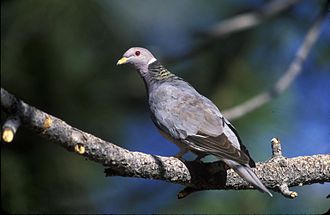Field Guide/Birds/Patagioenas fasciata
| Patagioenas fasciata (Band-tailed Pigeon) | |
|---|---|
| Description | |
| The Band-tailed Pigeon, Patagioenas fasciata, is a medium-sized bird of the Americas.
It ranges from British Columbia, Utah, and Colorado south in higher elevations through Mexico and Central America to northern Argentina. In autumn it migrates out of the part of its range north of California, New Mexico, and west Texas. Populations from Costa Rica south are sometimes considered a separate species, the White-naped Pigeon, C. albilinea. It is found at altitudes from 900 m to 3600 m, generally in oak, pine-oak, and coniferous forests. It feeds on seeds, notably acorns. It is the biggest pigeon in North America, averaging 34 to 36 cm This species is relatively quiet for a pigeon. Its voice is low-pitched and owl-like, often in two-syllable calls that rise and than fall (huu-ooh) with even spacing between calls. It builds a rudimentary platform nest out of twigs, in which it lays one or two eggs. Outside the breeding season it forms flocks, sometimes over 50 birds, and often becomes nomadic, following the acorn crop or moving to lower altitudes or other areas outside its breeding range. It often visits bird feeders. | |

